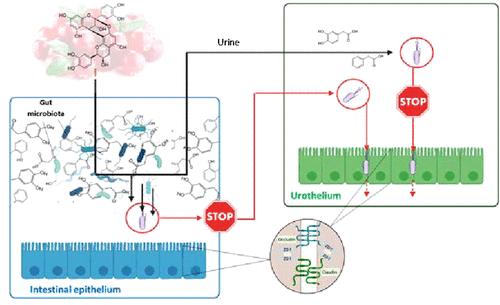当前位置:
X-MOL 学术
›
J. Agric. Food Chem.
›
论文详情
Our official English website, www.x-mol.net, welcomes your feedback! (Note: you will need to create a separate account there.)
Cranberry Polyphenols and Prevention against Urinary Tract Infections: New Findings Related to the Integrity and Functionality of Intestinal and Urinary Barriers
Journal of Agricultural and Food Chemistry ( IF 6.1 ) Pub Date : 2024-04-23 , DOI: 10.1021/acs.jafc.3c07169 Dolores González de Llano 1 , Mikel Roldán 1 , Diego Taladrid 1 , Edgard Relaño de la Guía 1 , M. Victoria Moreno-Arribas 1 , Begoña Bartolomé 1
Journal of Agricultural and Food Chemistry ( IF 6.1 ) Pub Date : 2024-04-23 , DOI: 10.1021/acs.jafc.3c07169 Dolores González de Llano 1 , Mikel Roldán 1 , Diego Taladrid 1 , Edgard Relaño de la Guía 1 , M. Victoria Moreno-Arribas 1 , Begoña Bartolomé 1
Affiliation

|
This work seeks to generate new knowledge about the mechanisms underlying the protective effects of cranberry against urinary tract infections (UTI). Using Caco-2 cells grown in Transwell inserts as an intestinal barrier model, we found that a cranberry-derived digestive fluid (containing 135 ± 5 mg of phenolic compounds/L) increased transepithelial electrical resistance with respect to control (ΔTEER = 54.5 Ω cm2) and decreased FITC-dextran paracellular transport by about 30%, which was related to the upregulation of the gene expression of tight junction (TJ) proteins (i.e., occludin, zonula occludens-1 [ZO-1], and claudin-2) (∼3–4-fold change with respect to control for claudin-2 and ∼2–3-fold for occludin and ZO-1). Similar protective effects, albeit to a lesser extent, were observed when Caco-2 cells were previously infected with uropathogenic Escherichia coli (UPEC). In a urinary barrier model comprising T24 cells grown in Transwell inserts and either noninfected or UPEC-infected, treatments with the cranberry-derived phenolic metabolites 3,4-dihydroxyphenylacetic acid (DOPAC) and phenylacetic acid (PAA) (250 μM) also promoted favorable changes in barrier integrity and permeability. In this line, incubation of noninfected T24 cells with these metabolites induced positive regulatory effects on claudin-2 and ZO-1 expression (∼3.5- and ∼2-fold change with respect to control for DOPAC and ∼1.5- and >2-fold change with respect to control for PAA, respectively). Overall, these results suggest that the protective action of cranberry polyphenols against UTI might involve molecular mechanisms related to the integrity and functionality of the urothelium and intestinal epithelium.
中文翻译:

蔓越莓多酚和预防尿路感染:与肠道和尿路屏障的完整性和功能相关的新发现
这项工作旨在产生关于蔓越莓对尿路感染(UTI)保护作用的机制的新知识。使用 Transwell 插入物中生长的 Caco-2 细胞作为肠屏障模型,我们发现蔓越莓来源的消化液(含有 135 ± 5 mg 酚类化合物/L)相对于对照增加了跨上皮电阻(ΔTEER = 54.5 Ω cm)2 ) 并减少 FITC-葡聚糖旁细胞转运约 30%,这与紧密连接 (TJ) 蛋白(即 occludin、zonula occlusionns-1 [ZO-1] 和 claudin-2)基因表达的上调有关)(claudin-2 相对于对照变化约 3–4 倍,occludin 和 ZO-1 相对于对照变化约 2–3 倍)。当 Caco-2 细胞先前感染尿路致病性大肠杆菌(UPEC) 时,观察到类似的保护作用,尽管程度较小。在包含在 Transwell 插入物中生长的 T24 细胞且未感染或 UPEC 感染的泌尿屏障模型中,用蔓越莓衍生的酚类代谢物 3,4-二羟基苯乙酸 (DOPAC) 和苯乙酸 (PAA) (250 μM) 进行治疗也促进了良好的尿路屏障。屏障完整性和渗透性的变化。在该细胞系中,将未感染的 T24 细胞与这些代谢物一起孵育,可诱导对claudin-2和ZO-1表达的正向调节作用(相对于DOPAC对照,变化约3.5倍和约2倍,相对于DOPAC对照,变化约1.5倍和>2倍)分别相对于 PAA 的控制发生变化)。总的来说,这些结果表明蔓越莓多酚对尿路感染的保护作用可能涉及与尿路上皮和肠上皮的完整性和功能相关的分子机制。
更新日期:2024-04-25
中文翻译:

蔓越莓多酚和预防尿路感染:与肠道和尿路屏障的完整性和功能相关的新发现
这项工作旨在产生关于蔓越莓对尿路感染(UTI)保护作用的机制的新知识。使用 Transwell 插入物中生长的 Caco-2 细胞作为肠屏障模型,我们发现蔓越莓来源的消化液(含有 135 ± 5 mg 酚类化合物/L)相对于对照增加了跨上皮电阻(ΔTEER = 54.5 Ω cm)2 ) 并减少 FITC-葡聚糖旁细胞转运约 30%,这与紧密连接 (TJ) 蛋白(即 occludin、zonula occlusionns-1 [ZO-1] 和 claudin-2)基因表达的上调有关)(claudin-2 相对于对照变化约 3–4 倍,occludin 和 ZO-1 相对于对照变化约 2–3 倍)。当 Caco-2 细胞先前感染尿路致病性大肠杆菌(UPEC) 时,观察到类似的保护作用,尽管程度较小。在包含在 Transwell 插入物中生长的 T24 细胞且未感染或 UPEC 感染的泌尿屏障模型中,用蔓越莓衍生的酚类代谢物 3,4-二羟基苯乙酸 (DOPAC) 和苯乙酸 (PAA) (250 μM) 进行治疗也促进了良好的尿路屏障。屏障完整性和渗透性的变化。在该细胞系中,将未感染的 T24 细胞与这些代谢物一起孵育,可诱导对claudin-2和ZO-1表达的正向调节作用(相对于DOPAC对照,变化约3.5倍和约2倍,相对于DOPAC对照,变化约1.5倍和>2倍)分别相对于 PAA 的控制发生变化)。总的来说,这些结果表明蔓越莓多酚对尿路感染的保护作用可能涉及与尿路上皮和肠上皮的完整性和功能相关的分子机制。



























 京公网安备 11010802027423号
京公网安备 11010802027423号